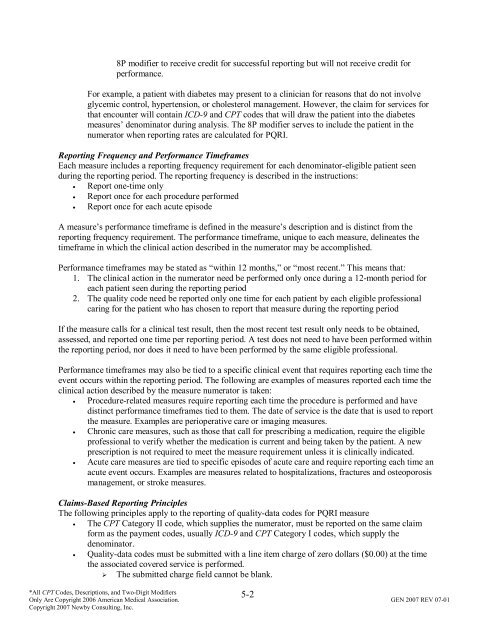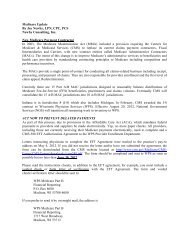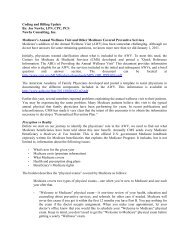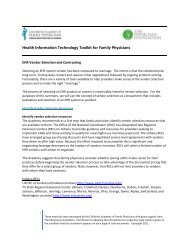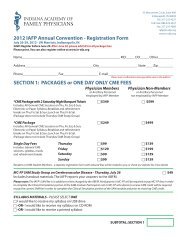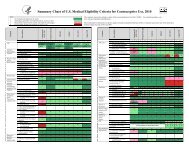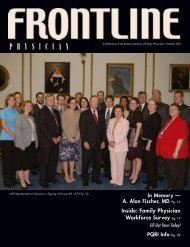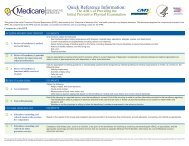pqri measure coding and reporting principles - Indiana Academy of ...
pqri measure coding and reporting principles - Indiana Academy of ...
pqri measure coding and reporting principles - Indiana Academy of ...
You also want an ePaper? Increase the reach of your titles
YUMPU automatically turns print PDFs into web optimized ePapers that Google loves.
8P modifier to receive credit for successful <strong>reporting</strong> but will not receive credit for<br />
performance.<br />
For example, a patient with diabetes may present to a clinician for reasons that do not involve<br />
glycemic control, hypertension, or cholesterol management. However, the claim for services for<br />
that encounter will contain ICD-9 <strong>and</strong> CPT codes that will draw the patient into the diabetes<br />
<strong>measure</strong>s’ denominator during analysis. The 8P modifier serves to include the patient in the<br />
numerator when <strong>reporting</strong> rates are calculated for PQRI.<br />
Reporting Frequency <strong>and</strong> Performance Timeframes<br />
Each <strong>measure</strong> includes a <strong>reporting</strong> frequency requirement for each denominator-eligible patient seen<br />
during the <strong>reporting</strong> period. The <strong>reporting</strong> frequency is described in the instructions:<br />
• Report one-time only<br />
• Report once for each procedure performed<br />
• Report once for each acute episode<br />
A <strong>measure</strong>’s performance timeframe is defined in the <strong>measure</strong>’s description <strong>and</strong> is distinct from the<br />
<strong>reporting</strong> frequency requirement. The performance timeframe, unique to each <strong>measure</strong>, delineates the<br />
timeframe in which the clinical action described in the numerator may be accomplished.<br />
Performance timeframes may be stated as “within 12 months,” or “most recent.” This means that:<br />
1. The clinical action in the numerator need be performed only once during a 12-month period for<br />
each patient seen during the <strong>reporting</strong> period<br />
2. The quality code need be reported only one time for each patient by each eligible pr<strong>of</strong>essional<br />
caring for the patient who has chosen to report that <strong>measure</strong> during the <strong>reporting</strong> period<br />
If the <strong>measure</strong> calls for a clinical test result, then the most recent test result only needs to be obtained,<br />
assessed, <strong>and</strong> reported one time per <strong>reporting</strong> period. A test does not need to have been performed within<br />
the <strong>reporting</strong> period, nor does it need to have been performed by the same eligible pr<strong>of</strong>essional.<br />
Performance timeframes may also be tied to a specific clinical event that requires <strong>reporting</strong> each time the<br />
event occurs within the <strong>reporting</strong> period. The following are examples <strong>of</strong> <strong>measure</strong>s reported each time the<br />
clinical action described by the <strong>measure</strong> numerator is taken:<br />
• Procedure-related <strong>measure</strong>s require <strong>reporting</strong> each time the procedure is performed <strong>and</strong> have<br />
distinct performance timeframes tied to them. The date <strong>of</strong> service is the date that is used to report<br />
the <strong>measure</strong>. Examples are perioperative care or imaging <strong>measure</strong>s.<br />
• Chronic care <strong>measure</strong>s, such as those that call for prescribing a medication, require the eligible<br />
pr<strong>of</strong>essional to verify whether the medication is current <strong>and</strong> being taken by the patient. A new<br />
prescription is not required to meet the <strong>measure</strong> requirement unless it is clinically indicated.<br />
• Acute care <strong>measure</strong>s are tied to specific episodes <strong>of</strong> acute care <strong>and</strong> require <strong>reporting</strong> each time an<br />
acute event occurs. Examples are <strong>measure</strong>s related to hospitalizations, fractures <strong>and</strong> osteoporosis<br />
management, or stroke <strong>measure</strong>s.<br />
Claims-Based Reporting Principles<br />
The following <strong>principles</strong> apply to the <strong>reporting</strong> <strong>of</strong> quality-data codes for PQRI <strong>measure</strong><br />
• The CPT Category II code, which supplies the numerator, must be reported on the same claim<br />
form as the payment codes, usually ICD-9 <strong>and</strong> CPT Category I codes, which supply the<br />
denominator.<br />
• Quality-data codes must be submitted with a line item charge <strong>of</strong> zero dollars ($0.00) at the time<br />
the associated covered service is performed.<br />
! The submitted charge field cannot be blank.<br />
*All CPT Codes, Descriptions, <strong>and</strong> Two-Digit Modifiers<br />
Only Are Copyright 2006 American Medical Association. GEN 2007 REV 07-01<br />
Copyright 2007 Newby Consulting, Inc.<br />
5-2


